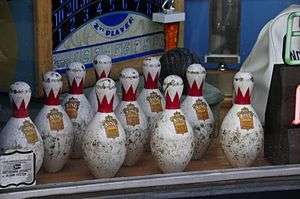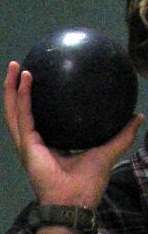Duckpin bowling

Duckpin bowling is a variation of 10-pin bowling. The balls used in duckpin bowling are 4 3⁄4 in (12 cm) to 5 in (12.7 cm) in diameter (which is slightly larger than a softball), weigh 3 lb 6 oz (1.5 kg) to 3 lb 12 oz (1.7 kg) each, and lack finger holes. They are thus significantly smaller than those used in ten-pin bowling but are slightly larger and heavier than those used in candlepin bowling. The pins, while arranged in a triangular fashion identical to that used in ten-pin bowling, are shorter, smaller, and lighter than their ten-pin equivalents, which makes it more difficult to achieve a strike. For this reason (and similar to candlepin bowling), the bowler is allowed three rolls per frame (as opposed to the two rolls per frame in ten-pin bowling).
Rules
Duckpin bowling has rules similar to ten-pin bowling. In a 10-frame game, bowlers try to knock down pins in the fewest rolls per frame. Bowlers have three balls per frame, instead of two in ten-pin bowling, to knock over a set of 10 pins. If a bowler knocks down all 10 pins with their first roll in a frame, it is scored as a strike. If all the pins are knocked down in two rolls, the bowler has made a spare. If all the pins are knocked down in three rolls, it is scored as a ten, as in candlepins, with no bonus. If pins are still standing after the third ball, the bowler gets one point for each pin knocked down.

In the case of a strike, the bowler gets 10 points plus the total number of pins knocked down with the next two balls rolled, for a maximum of 30 points. In the case of a spare, the bowler gets 10 points plus the number of pins knocked down with the next ball, for a maximum of 20 points. If it takes three balls to knock down all 10 pins, the bowler gets 10 points, with no bonus. A bowler's final score is the sum of the points earned over 10 frames (a spare or strike in the tenth frame earns one or two rolls respectively). The maximum possible score of 300 points, which is accomplished by rolling 12 strikes in a row, has never been achieved under official conditions. According to the NDBC, the official high score in a sanctioned game is 279, rolled by Pete Signore Jr. in 1992.[1]
History
The origin of the sport is a subject of some debate. One possible origin is that duckpin bowling began in Baltimore around 1900, at a bowling, billiards and pool hall owned by future baseball Hall of Famers John McGraw and Wilbert Robinson, both of the then Baltimore Orioles.
An article from May 1894 in the Lowell Sun confirms the existence of duckpins. An early claim is found in the Pittsburgh Press of March 3, 1929.[2]
In 1953, inventor Ken Sherman introduced the first automatic duckpin pinsetter, produced from 1953 to 1973. This model, named after him, was very popular amongst duckpin lanes nationwide and is still the most common pinsetter found in duckpin locations.
In 1982, the Women's National Duckpin Association was formed to give women a venue to compete in duckpins at a professional level. The organization conducts several tournaments yearly in New England and the Mid-Atlantic. The final tournament each year is called the Grand Prix.[3]
The origin of candlepin bowling (which shares many similarities to duckpin, including a smaller ball and three bowls to clear all the pins) has also been traced to New England; in particular, to the Massachusetts city of Worcester in 1880.
Variants
In 1905 a variant called rubber band duckpins was introduced in the Pittsburgh, Pennsylvania area by William Wuerthele,[4] in which the pins are circled with hard rubber bands to increase action and scoring. Wuerthele observed bowlers wasting their third ball as well as flying pins injuring pin boys, so, according to a defunct publication called The Ducks, Wuerthele added the rubber band to increase scoring. The American Duckpin Congress was formed in the 1920s to govern the game of rubber band duckpins. The organization later became the American Rubber Band Duckpin Bowling Congress in 1945 and became an affiliate of the National Duckpin Bowling Congress. The rubber band game is now almost extinct, with most of the lanes located in private clubs. There is one alley in the U.S. still open to the public in Glassport, Pennsylvania. Rubber band duckpin is the only version of duckpin played in the province of Quebec, where it has retained a certain degree of popularity. The rubber band game is also played in at least one dual tenpin/duckpin bowling centre in Markham, Ontario. A family entertainment center and resort in Hayden, Idaho offers two lanes of rubber band duckpins alongside its normal tenpin facility. Bowlers tend to throw slowly with their fingers facing forward to give the ball backspin. There have been perfect games bowled in rubber band duckpin, including the largest duckpin prize ever won on television, C$50,000 in 1994.[5] Since it is easier to knock down pins in rubber band duckpin, its rules are identical to those of standard ten-pin bowling.
Locations
In the United States, duckpin bowling centers are rarer than ten-pen centers. Duckpin bowling centers are located in Connecticut, Massachusetts (principally in and near its South Coast communities), Rhode Island, Chicago, Indiana (Fountain Square), Maine, Maryland (especially in the Baltimore area), Wisconsin, Virginia, Ohio, Georgia, and in suburban Washington, D.C. The last duckpin bowling center in Pennsylvania is at Rockwell Lanes located in Gettysburg, Pennsylvania. There is also one located in Potter, Nebraska, the only one of its kind west of the Mississippi River until construction of the one in Spanish Fork, Utah is complete. In a resurgent area downtown, The Woolworth in Birmingham, Alabama has 8 dedicated duckpin lanes. Washington state recently added the first Duckpin bowling in the west in Gig Harbor, WA at Ocean5.
References
- ↑ "Duckpin World Records". National Duckpin Bowling Congress. Retrieved 2016-05-26.
- ↑ WILBERT ROBINSON CLAIMS HE INVENTED DUCKPINS; "Uncle Robby" Gave Shaved Down Tenpins Their Present Name.; LOOKED LIKE DUCK; Game Has Big Hold In East Now as Well as in Pittsburgh., by Fred Turbyville; in the Pittsburgh Press (via Google News); published March 3, 1929; retrieved July 12, 2014
- ↑ "Women's National Duckpin Association". Wndatour.com. Retrieved 2009-07-26.
- ↑ Historical Dictionary of Bowling (2014) by John Grasso and Eric R. Harman
- ↑ "Quilles G plus". 2007-03-21. Archived from the original on 2007-04-02.
- The Ducks Magazine, October 1928, Pittsburgh Pennsylvania
External links
- Duckpins.com - Duckpin bowling information and history.
- National Duckpin Bowling Congress
- Women's National Duckpin Association
- Duckpin Professional Bowlers Association (new URL)
- A July 7, 2007, feature story on duckpin bowling in the Press Box, a Baltimore sports weekly (with a sidebar on the right-hand side of the text, starting partially down the page, citing the refutation of Baltimore as the alleged origin of the sport of duckpin bowling)
- A duckpin bowling score calculator
- A Sherman duckpin pinspotter in action
- Frontside view of the Sherman pinspotter in action
- Duckpin bowling - Campeonato Argentino de Bowling 2009